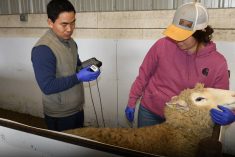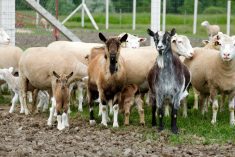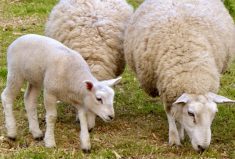Cache Valley virus can devastate sheep breeding operations without warning, causing reproductive losses which are potentially catastrophic especially for smaller operations.
Cache Valley virus is a mosquito-borne disease which was first discovered in Utah’s Cache Valley in 1956. It has spread across North America over the decades, posing a threat primarily to producers in regions with significant mosquito populations.
It primarily affects sheep, but it has also been found in other small ruminants such as goats.
Read Also

High prices, lower demand challenges producers
Large capital investments coupled with consumer demand makes for long-term planning among Canadian cattle producers
No vaccine or treatment exists for Cache Valley virus, which can cause abortions and stillbirths in small ruminants such as sheep.
“We’ve seen producers lose up to 30 per cent of their lamb crop in a single season,” said Saskatchewan-based veterinarian Heidi Dubé, while speaking at the Alberta Sheep Breeders Association symposium in Camrose in October.
“The virus can cause extreme birth defects, including scoliosis, fused joints and neurological complications.”

The virus has been found to only impact pregnant sheep in the first 48 days of pregnancy. Dubé said that although about 65 per cent of sheep which have been tested show exposure to the virus, it is only those in the early weeks of pregnancy that are vulnerable to its effects.
“Non-pregnant ewes or sheep that are pregnant beyond that 48 days typically don’t show any clinical disease at all and are typically able to mount a very good immune response to the virus and have no impact on the pregnancy whatsoever,” she said.
“However, in the case of a pregnant ewe during her first trimester, the virus could cross the placenta to infect the fetus, resulting in the symptoms of abortions, stillbirth, congenital defects and so on.”
Steps for prevention
Dubé said there are certain types of mosquitoes that are known to be more likely to carry Cache Valley virus, but studies have shown that more and more varieties of mosquitoes are being found to carry it as well.
There is no vaccine for prevention, and Dubé says there are none on the way. But other steps can be taken to try to prevent infection in sheep.
Since the virus is solely spread through mosquito bites, the first option would be to adjust your operation’s breeding season to early spring or late fall to avoid mosquito season altogether.
If that is not feasible on your operation, managing standing water in the area could play a large role in minimizing the mosquito population on your property.
“Standing water that doesn’t get disturbed at all is your highest source of mosquitoes. Draining all your water pails or emptying your tire swings or any other source of standing water is worth thinking about,” Dubé said.
“The basic gist is that wherever you can reduce any standing water, I would encourage you to do so.”
Testing infected fetuses
Diagnosis of the virus remains challenging, with most detection occurring through postmortem examination of aborted fetuses.
Dubé said it would be beneficial for producers to have their fetuses or stillborn lambs tested for the virus. At worst, it would give the producer peace of mind that another more serious issue is not present in their flock.
“What I have found when I’ve tested, I really like the elimination of diagnosis.”
Human transmission
Cache Valley virus can be transmitted to humans, although it is rare.
Symptoms in humans are generally flu-like, so human transmissions of Cache Valley virus often go unreported.
Future outlook
Dubé said there are really no expectations for a vaccine or treatment for Cache Valley virus on the horizon. But the hope is that, with time, ewes will be able to develop an immunity to the virus.
“There’s lots of questions about it that we don’t have answers for right now. I think there’s a lot of hope that they get long-term immunity to it, but we really don’t know yet,” she said.














